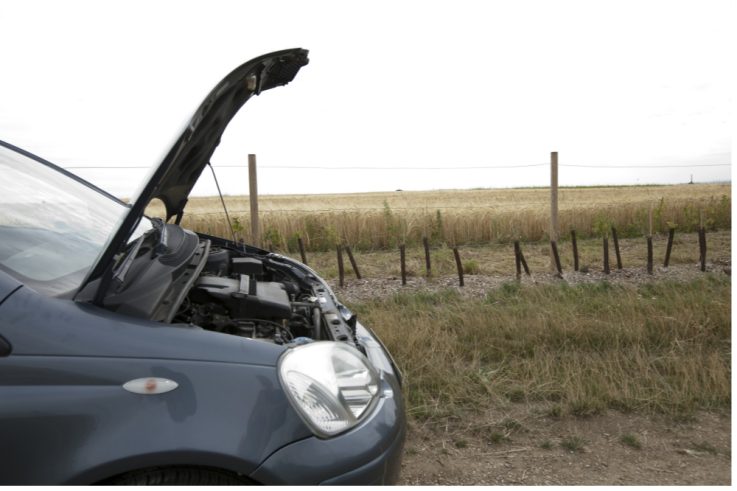If you should encounter some kind of difficulty with your vehicle while driving, the first thing you should do is try to maneuver to the shoulder of the road as soon as you can. This is especially true if you’re on the highway, because vehicle traffic will be traveling at high speed, and if your car is actually breaking down, it could create a very hazardous situation. Safety should be uppermost in your mind in a situation like this, so you should keep a couple of things in mind.
First of all, it’s a good idea to coast along the shoulder of the road until you reach a straight stretch of highway, with no curves in the road behind you. This will allow you to see any oncoming traffic, and it will also allow vehicles behind you to be well aware of your position at the roadside. If it happens that your engine suddenly dies while you’re in the middle of traffic on the highway, and you have no opportunity to reach the shoulder, you should make sure to stay in the vehicle.
It can be extremely disconcerting to be sitting in a non-operational vehicle with high-speed traffic all around you, but if you were to get out of the vehicle and try and reach the side of the road, you might run into a much worse situation. Keep in mind: police officers generally patrol highways, so more than likely a Highway Patrol officer will be along shortly.
Tips for Staying Safe
If your vehicle requires auto collision repair work on the road, that’s something you can work on after the fact. Your immediate concern is to stay safe, and to try to keep your vehicle free from harm, given the fact that you are in a dangerous situation that could have the potential for disaster.
Here are some things you should do to keep yourself and your vehicle safe before you make it to the auto collision repair shop:
- Hang some white cloth from the window– roll down the driver-side window, and hang out either a white piece of cloth or paper and then you can roll the window back up to ensure that it stays in place. This will alert drivers and authorities to the fact that your vehicle is in distress, and that they should go around you, and leave you out of the traffic flow.
- Call someone– the minute you know that you are going to require roadside assistance, you should use your cell phone to contact your roadside assistance club or the Highway Patrol. If you don’t have a cell phone, there may be an emergency call box nearby, and you can use this to call for help and then get back to the safety of your vehicle. If you can’t find a call box anywhere in the area, you’ll have to rely on your white distress flag to alert someone to the fact that you need help.
- Do not work on your vehicle– whatever you do, don’t get outside the vehicle and begin working on it, especially on the side of the vehicle that is closest to traffic. You might easily be struck by a passing vehicle, and that could be catastrophic. If it’s possible, maneuver your vehicle to a safe location, and then you will be able to inspect your vehicle for damage, and possibly conduct field repairs.
- Put on emergency blinkers– it’s best if you can alert other motorists to the fact that your vehicle is non-operational, although you probably shouldn’t do this at night. It’s not a good idea at nighttime because any vehicle drivers coming up behind you could mistakenly assume that your vehicle is still moving along the highway, and that could result in your vehicle being rear-ended.
- Place reflective markers behind your vehicle– if you have reflective markers or warning lights, these should be placed about six feet behind your vehicle to alert other drivers to the fact that you’re non-operational. As soon as you have placed these, you should return to the safety of your car. If you don’t have either one of them, you can leave open one of the car doors on the side of your vehicle away from traffic.
- Be careful about changing flat tires– if you’ve experienced a flat tire while driving, make sure that you can get well off the road before attempting to change it. If the flat is on the side of your vehicle which is nearest to traffic, it’s better that you don’t attempt to change it yourself, and that you simply call for roadside assistance. If the flat tire is on the side of your car away from traffic, then it should be safe enough for you to proceed with swapping out the tires.
Auto Collision Repair Tips
if your vehicle has sustained some kind of damage from your mishap while driving, here are some repair tips you should be aware of:
- Dents– whenever you have to deal with dents, make sure to have good illumination in your work area, and also make sure that you have on hand plenty of sandpaper, hammers, dollies, and paint. You should never put more than 1/8 of an inch of filler on a dent repair.
- Sanding– don’t use your bare hands to accomplish any sanding work, and instead, make sure to have a sanding block or a sponge to support the sandpaper. If you try sanding with your bare hands, it will create grooves from your fingers that tend to press harder than your palm does. A sanding block ensures that the job will be done smoothly, and all you need is a light touch to get the work done.
- Guide coats– these work by depositing a very thin layer of paint or dust all across the primer surface. They help you to identify low spots when you’re sanding down your vehicle at the auto collision repair shop.
- Welding clamp– use a sheet metal screw to get your panel in place, and then drill a pilot hole which you can run the screw through. This will hold your panels in place so you can do the welding work, and once you’re finished, a small spot weld will fill in the entire whole.
- Straight edge– a straight edge is ideal for roughing in some bodywork while using a hammer and dolly. Generally what you’ll need is a 2-foot strip of steel or aluminum which has a perfectly straight edge. When working with a broad dent, you’ll be able to use the straight edge to spot any low areas easily. If you run some masking tape along the length of the edge, it will also protect against any scratches in the paint.


